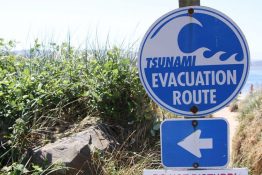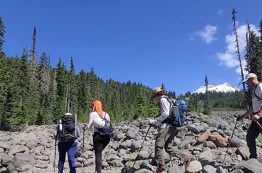The National Science Foundation has funded a multi-institutional team led by Oregon State University and the University of Washington to work on increasing resiliency among Pacific Northwest coastal communities. The new Cascadia Coastlines and Peoples Hazards Research Hub will serve coastal communities in Northern California, Oregon and Washington. The hub’s multidisciplinary approach will span geoscience, social science, public policy and community partnerships.
Read more at UW News »A visit to Mt. Baker’s Easton Glacier
This week, a few members of the UW News team joined glaciologists from the UW Department of Earth & Space Sciences on a trip to Mt. Baker. Students that came along got a pop quiz on glaciology from their professor on the hike up, and learned about how the recent heat wave impacted the snow melt on the ice. Taryn Black, a PhD candidate in the department, led the hike and is featured in this video.
Read more at UW News »UW launches GeoHazards Initiative; names Paros Chair in Seismology and GeoHazards
Leveraging the tectonic laboratory of the Cascadia subduction zone, the University of Washington today announced a new effort to best understand how to study and live with the threats of earthquakes, tsunamis, volcanos, landslides and other seismic hazards. Dubbed the GeoHazards Initiative, the interdisciplinary work aims to develop and promote the adoption of early detection systems both on land and at sea to help prevent the loss of human life and property.
Read more at UW News »Is potassium a key to understanding the ocean’s past?
When looking at a periodic table, potassium might not be the first element you’re drawn to – distracted instead by gold, copper or silver. But a new paper published in Science Advances suggests we should be paying more attention to this abundant substance. The study – with first author Yan Hu, a recent graduate student and postdoctoral researcher in the UW Department of Earth and Space Sciences and now at Institut de Physique du Globe de Paris – advances our ability to trace potassium isotopes at high precision, unleashing a suite of potential applications ranging from measuring past climates to further understanding ocean chemistry.
Read more »Ice within Mount Everest holds key to the past, hints at future
Last year for International Mountain Day, we visited the shores of Mauna Kea in Hawaii and learned that it’s the tallest mountain in the world when measured from the base underwater up to the top. This year, we are travelling to colder climates to the highest mountain in the world when measured from sea level: Mount Everest. Department of Earth and Space Sciences’ Howard Conway officially had one of the most scenic offices in the world when he conducted field work on the Khumbu Glacier, one of the four major glaciers that flank Mount Everest.
Read more »





